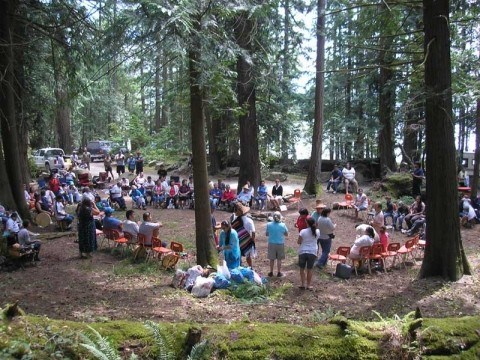It's up to the people now.
The Governments of Canada and British Columbia have officially made their final pitches for an In-SHUCK-ch treaty, bringing an end to negotiations that have dragged on for 17 years.
The Final Closing Elements of the treaty, obtained by Pique last week, offer a total 16,356 hectares of land to the In-SHUCK-ch Nation including 15,016 hectares of Crown land and 1,284 hectares of existing reserve lands that are already registered to the Douglas, Skatin and Samahquam First Nations.
They also offer a capital transfer of $34.697 million - about a third of which will pay down federal debt that the In-SHUCK-ch took on to participate in negotiations.
Negotiators for the In-SHUCK-ch Nation, as well as the federal and provincial governments, will now likely sign a final agreement and hand it off to the participating First Nations for consideration and possible ratification - something that will not happen until October or November, according to In-SHUCK-ch negotiator Gerard Peters.
There are 931 people divided between all three First Nations, but to vote on the treaty members must enroll as In-SHUCK-ch citizens.
The land being offered to In-SHUCK-ch extends from the southern end of Lillooet Lake to the north end of Harrison Lake, with several detached pieces in between. In addition to the Douglas, Samahquam and Skatin reserves it cedes federal and Crown land to the First Nations that they can develop without seeking permission from the Minister of Indian and Northern Affairs.
"The treaty removes any reference to the Indian Act," Peters said. "We won't be Indians any longer, so there won't be any Indian bands."
Under section 18 of the Indian Act, the Crown holds reserve lands for the use and benefit of First Nation bands. The Governor-in-Council, in this case the Governor General acting on the advice of the federal cabinet, can determine any purpose for which reserve lands are to be used for a band's benefit.
The Minister of Indian and Northern Affairs can also authorize the use of reserve lands for the purpose of Indian schools, burial grounds, health projects or any other project for the general welfare of the band, according to the Act.
Under treaty, the In-SHUCK-ch won't have to go to the minister for those purposes anymore. The In-SHUCK-ch will have their own government, the ability to make their own laws and decide what to do with their land as they please.
"Indians don't own their Indian reserves," Peters said in an interview. "If they want to release a portion of it or log it for commercial purposes, they've got to get the approval of the Government of Canada.
"After treaty comes into effect, that'll be removed, it'll be replaced with our own law-making authority."
The In-SHUCK-ch won't just own the land - they'll also own all subsurface rights, meaning they'll own the land and everything under it. Peters said those rights are key to helping the In-SHUCK-ch communities develop an economic base through operations like gravel production and mineral extraction.
"Assuming a highway is something that's going to occur in the future, obviously you're going to need the material and if you're going to embark on a building program at all, same thing," Peters said.
Though the In-SHUCK-ch Nation is nearing a final treaty, it hasn't come smoothly.
Last March, in the weeks before the provincial election, negotiators with the In-SHUCK-ch Nation and the Government of British Columbia signed a bilateral agreement that drew the anger of the neighbouring Chehalis Band because the In-SHUCK-ch map included St'epsum, or 20 Mile Bay, a village that the Chehalis consider the "heart" of their territory.
Chehalis Chief Willie Charlie told Pique at the time that elders have been buried at St'epsum and that the area has helped give some members their aboriginal names.
Now, St'epsum has been removed and the In-SHUCK-ch are instead getting $6.5 million in capital transfers and 680 hectares of land at Fire Mountain - an increase of 40 hectares over the previous land quantity that the First Nation was seeking.
When interviewed last March, Peters was adamant about an In-SHUCK-ch claim to St'epsum but now says he's satisfied with the new arrangement.
"I received more than that land in my negotiations with the other parties," he said.
Gordon Mohs, Heritage Resources Advisor at the Chehalis Indian Band, declined to offer comment on St'epsum's removal from In-SHUCK-ch negotiations because the band is in "sensitive inter-tribal treaty negotiations" with the First Nation.
"I would say that after the end of the month, probably closer to mid-next month, we will probably have something we can say on this," he said.
Canada and B.C.'s offerings to In-SHUCK-ch
Total quantum of land: 16,356 hectares
• Provincial Crown land: approximately 15,016 hectares
• Federal land: approximately 5.5 hectares at the Baptiste Smith parcel
• Reserve land: approximately 1,284 hectares of existing reserve lands registered to Douglas First Nation, Skatin First Nation and Samahquam First Nation
• District Lot 1747: approximately 50.4 hectares of fee simple lands acquired by Canada and British Columbia through a Treaty-Related Measure
Total capital transfer: $34.697 million
• Capital Transfer of $19.353 million
• Capital Transfer of $5.615 million in lieu of Resource Revenue Sharing (RRS) - In-SHUCK-ch rejected offer to share resource revenues with the Province of B.C. earlier this year
• Capital Transfer of $6.5 million in compensation for 20 Mile Bay
• Additional Capital Transfer of $1.7 million




